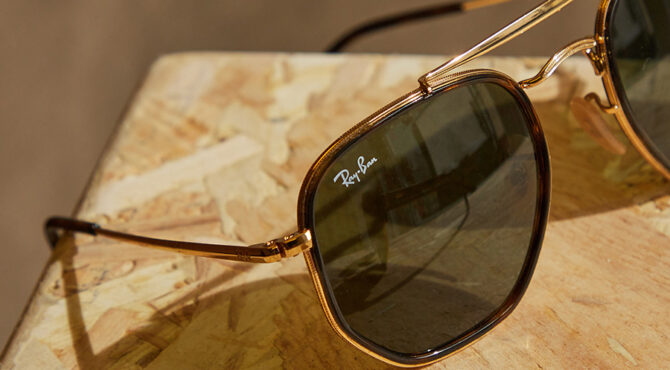
Ray Ban: Brand Guide
Explore the Iconic World of Ray-Ban Sunglasses
They’re one of the most iconic, instantly recognisable and sought after brands on earth, and the undisputed champion of mastering the art of stylish eyewear. From film stars and sporting legends, to the front men of rock and roll bands and even some of the former presidents of the United States, Ray Ban knows no boundaries when it comes to the conformity of style, or the way in which their frames can shape not only a generation, but a timelessly cool culture, with one simple signature logo.
Ray Ban History
Founded in 1934 in America, RayBan made its name through aviation. In a time where planes were going higher than ever, and had the range to travel distances that a lack of technology had previously inhibited, US Air Force pilots began to complain of headaches and altitude sickness from the increased amount of glare from the sun. Ray Ban saw their opportunity and stepped in, introducing a plastic frame with a green lens that would reduce glare without obscuring the pilot’s vision. It was this frame that sealed Ray Ban’s instant success as a new eyewear brand, as the style was later remodelled with a metal frame and called the Ray Ban Aviator.
RayBan became renowned for their unique performance in different lights. Before long, their reputation had led to them being worn for much more than just flying. Anybody partaking in outdoor pursuits lusted after a pair of Ray Bans, with later models being released with different coloured lenses to reduce the effects of varying light conditions on the eye. From hunting, to rock climbing and fishing, Ray Ban’s seemed to work their way into every aspect of outdoor life.
Ray Ban’s Evolution
The 1940s saw Ray Ban develop the technology behind their lenses further, as gradient mirrored lenses protected pilots from the sun whilst allowing them to clearly see their dials in their lower field of vision. This military-inspired phenomenon spread to mainstream fashion, as ordinary people clamoured to get their hands on military-spec apparel.
The fashion after the war remained militarized; with civilians wearing Army issue t-shirts and pilot inspired clothing, including Ray Ban sunglasses to imitate their style. The implications of this shift in fashion were huge for Ray Ban – it meant that they had just managed to become a mainstream fashion eyewear brand without having to change a thing.
The wake of the war saw a shift in American culture. Hollywood boomed and the rise of the film star became unstoppable. It was during this time that Ray Ban introduced what is now perhaps one of their most recognisable styles, the Wayfarer. The squared-off frame was worn on-screen by the likes of Audrey Hepburn in “Breakfast at Tiffany’s” and James Dean in “Rebel Without a Cause”, which led to some of Ray Ban’s greatest exposure, as their styles were displayed on the big screen by some of the most culturally significant figures of all time. The boom continued well into the 1960s, with even more styles being added to the Ray Ban range, including frames for men, women and children.
Ray Ban’s In Pop-Culture
The more recent years have seen Ray Ban continue their venture into popular culture. From Tom Cruise sporting the Ray Ban Aviator in “Top Gun” to a huge host of their styles appearing in one of Quentin Tarantino’s most celebrated films, “Reservoir Dogs”, Ray Bans have been displayed at the movies since their early popularity. With musicians such as Kanye West, Liam Gallagher and Rihanna being spotted wearing RayBan frames, there are no boundaries to which the American label can adhere too. With Ray Ban styles using their huge cultural references to transcend any style, they have always remained as pricelessly stylish no matter what look they are used in.
With constant updates and innovations, including the reworking of timeless frames like the Wayfarer to create newer, sleeker versions, whilst also still maintaining production of the classic style, Ray Ban is one of the few brands in the world that can appeal to any gender and generation.
However, despite their unrivalled level of popularity thanks to their undoubted style, Ray Ban’s haven’t forgotten their roots of technological lens innovation. Still developing new tints and designs for the lenses to fit their sough-after frames, Ray Ban still provide everything from fully mirrored lenses on their classic Aviators, to the traditional green lens on their iconic Wayfarer, making them one of the most successful eyewear brands of all time.





